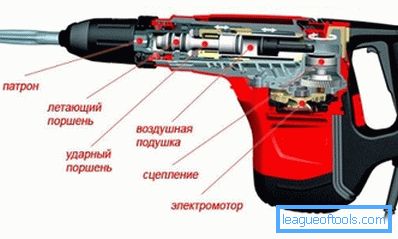How to use a punch
The perforator allows you to perform a wide range of jobs. In some cases, it is impossible to do without it. However, in order to effectively use all of its capabilities, you need to know how to use a punch.

Diagram of the device punch.
Punch device
In appearance, the hammer drill is similar to a hand-held electric drill. This is where almost all the similarities end.

Technical characteristics of punchers with a different internal volume.
The energy of the engine is transferred to the working tool using a percussion mechanism, made on the basis of a crank mechanism (for medium and heavy models) or a swinging bearing (for light punchers). Both mechanisms drive the piston.
The piston moves in the cylinder body, periodically creating a vacuum or excessive pressure in it. The alternating pressure change in the cylinder acts through the transfer element (ram) on the working tool, causing it to make reciprocating movements.
The working tool is fastened in the chuck equipped with an SDS quick-clamping system. Such a system requires from the installed interchangeable tools specialized form of the shank. Conventional cylindrical shanks are not suitable in this case.
On the case of the cartridge has a special mounting ring. Depending on the design, pushing the ring or turning it, unlocks the seat in the cartridge. Releasing the ring, you can back lock the seat with a removable tool installed.

Overview of perforator features.
The puncher, depending on the model, can have a number of controls that greatly facilitate the work and extend its functionality:
- Mode switch.
- The engine speed control. Regulation is carried out by changing the force applied to the start button. The more pressed into the body, the greater the number of revolutions issued by the engine.
- The switch of the direction of rotation of the engine (reverse).
Modes of operation and equipment: the use of the tool
The use of perforator is most often associated with drilling holes in concrete. This operation is possible with percussion drilling, or, as it is also called, drilling. This is undoubtedly his most important function, where he is out of competition, but not the only one.
Along with the drilling mode there are several other modes of operation:

Diagram of the device components of the punch.
- Conventional drilling mode. Designed to make holes in materials where it is unacceptable or inappropriate to use the mode of percussion drilling.
- Shock mode. It allows the use of appropriate nozzles to produce the shaving of walls of brick, plaster, lightweight concrete.
The use of various tools and devices significantly expands the functionality of the tool:
- Drills and bits allow to drill various diameter in a brick, plaster, foam concrete blocks in the drilling mode and in concrete in the drilling mode.
- With the help of a chisel in percussion mode, it is possible to dismantle light partitions, tile, wall chipping.
- Using a special nozzle - a cam chuck with an SDS shank - a drill in drilling mode can use a snap for a handheld electric drill with straight cylindrical and hexagonal shanks (drills, cutters, grinding nozzles, mixers for mixing plastering and paintwork).
- If the structure has a reverse, it is possible to carry out functions characteristic of a screwdriver using a perforator. An adapter is installed in the keyless chuck, which allows the use of bits with interchangeable nozzles to tighten or loosen the nuts and screws.
Drilling and drilling perforator
Before starting work, the required tool is installed. The mode switch is set to the position corresponding to the nature of the work being done.
It is necessary to start drilling and drilling smoothly, without sharp jerks, gradually increasing the load.

Diagram of the device clamping cartridge.
This will allow for more accurate positioning of the hole at the beginning of work and will not allow it to move away from the intended path.
When making deep holes, the drill should be periodically pulled out and the tool be allowed to idle for a few seconds. As a result, two tasks are achieved: cooling the working element and cleaning the opening channel from dust and crumbs.
If you do not remove the punch from the hole, then nothing terrible will happen: the work will still be done. However, in this mode, increased wear and failure of both the cutting tool and the perforator itself occurs.
It is also sometimes necessary to observe how, instead of air cooling, some craftsmen put a jar of water near the workplace and dip the tip of the drill every time to cool it faster.
The saving of time at the same time turns out rather doubtful. But the working life of carbide tack due to a sharp temperature difference in a short time is produced.

Installation of the lever of switching of the modes on the perforator.
A very convenient and useful element in the punch is a removable adjustable handle-holder. The handle can be adjusted to a position that corresponds to individual anatomical features (it all depends on whether you are right-handed or left-handed).
The position of the handle will be affected by the work location. Often when working you have to rebuild because of a closely spaced wall, pipelines or furniture.
In some cases, for example, when working in hard-to-reach places, in cramped conditions, the handle has to be removed. Here, however, it must be borne in mind that the presence of the handle allows you to firmly hold the tool and its removal will require great effort to perform the work.
The depth of the hole can be roughly determined using a standard depth gauge (thin rod with a scale) attached to the handle-holder. The support platform of the depth gauge is set flush with the tip of the drill or drill. Then the rod is shifted by an amount equal to the depth of the hole, and is fixed in the desired position. The displacement is controlled on a scale applied to the surface of the rod. When the hole is made, the tool feed will be physically limited by the depth gauge position set.

Using a perforator, you can dismantle an old tile.
In the absence of such a standard fixture, it is easy to dispense with a strip of masking tape rolled several times glued on the surface of the drill. The depth of the hole will match the distance from the tip of the tool to the strip. Accuracy in this case will, of course, be very approximate, but quite sufficient to install an anchor or dowel in the wall.
An important nuance when working with a perforator is the choice of a stable, reliable working posture. This is explained not only by safety requirements, but also by the laws of physics. Without creating an initial effort on the tool, it is almost impossible to drill a hole, especially in stone or heavy reinforced concrete. The tool of its impact will actually move the person away without going into the material. Therefore, it is desirable to have a stop point when making holes.
When working in the drilling mode, the drill will rotate with a small axial runout, which must be taken into account. A similar phenomenon is observed when installing the cartridge adapter and using drills for metal and wood.
Back to table of contentsPerforator: use and application in percussion mode
In fact, the perforator percussion mode performs the work that was previously done with a hammer and chisel.

Vibration damping perforator.
That is, in shock mode, you can level the corner, the walls in the panel house, remove the old tile, remove the remains of the frozen solution. Using powerful models of punchers, it is possible to carry out dismantle of plaster and brick walls.
Shock mode is used when the walls are broken down under electrical wiring. According to the preliminary marking by the grinder or wall chaser, parallel cuts are made. The chisel installed in the cartridge removes the wall material between the slotted grooves, thereby forming a cable groove of the required depth.
The use of special nozzles allows for tamping of soil or any other backfill. The only thing to remember when using such a tool is the need for a short, intermittent mode of operation.
Another nontrivial application is the use of nozzles (sledgehammers) for driving wedges, dowels, large nails.
In any case, no matter what mode of operation is used, it is necessary to follow the safety rules when working with power tools and be sure to use personal protective equipment.